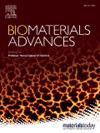Fibrin-targeted photosensitizer aggregates significantly enhance the delivery of chemotherapeutic drugs to tumor vasculature
IF 6
2区 医学
Q2 MATERIALS SCIENCE, BIOMATERIALS
Materials Science & Engineering C-Materials for Biological Applications
Pub Date : 2025-06-19
DOI:10.1016/j.bioadv.2025.214393
引用次数: 0
Abstract
Current drug carriers, while effective in mitigating therapeutic side effects, frequently elicit non-drug-related adverse reactions, including hepatorenal toxicity, oxidative stress and allergic responses. To address these issues and enhance drug efficacy, we propose a “drug-carrying-drug” strategy that integrates photodynamic therapy (PDT) with chemotherapy for potential tumor eradication. Traditional photosensitizers often confront a paradoxical dilemma between aggregation-induced photodynamic deactivation and dispersion-mediated premature photobleaching. To overcome these limitations, we developed PPCNM, a multifunctional micellar carrier. PPCNM is constructed by PEGylating pyropheophorbide-α (PPA), a porphyrin-based photosensitizer, and conjugating it with the tumor-targeting pentapeptide CREKA. Before entering tumor cells, PPCNM remains aggregated to prevent photobleaching. Upon internalization, it disassembles to activate PDT and stably delivers doxorubicin (DOX). DOX@PPCNM not only mitigates photobleaching and phototoxicity caused by premature PDT activation but also alleviates adverse effects associated with chemotherapeutic monotherapy. The fibrin- specific CREKA peptide, which targets tumor vasculature, improves the precise delivery of photosensitizers and chemotherapeutics to tumor tissues. Overall, this study presents a promising strategy for developing a dual-drug targeted delivery system combining PDT with other therapies.

纤维蛋白靶向光敏剂聚集体显著增强化疗药物向肿瘤血管的输送
目前的药物载体虽然能有效减轻治疗副作用,但经常引起非药物相关的不良反应,包括肝肾毒性、氧化应激和过敏反应。为了解决这些问题并提高药物疗效,我们提出了一种“药物携带-药物”策略,将光动力疗法(PDT)与化疗相结合,以实现潜在的肿瘤根除。传统的光敏剂往往面临着聚集诱导的光动力失活和分散介导的过早光漂白之间的矛盾困境。为了克服这些限制,我们开发了PPCNM,一种多功能胶束载体。PPCNM是由聚乙二醇化卟啉类光敏剂焦磷酸-α (PPA)与靶向肿瘤的五肽CREKA偶联而成。在进入肿瘤细胞之前,PPCNM保持聚集以防止光漂白。在内化后,它分解激活PDT并稳定地递送阿霉素(DOX)。DOX@PPCNM不仅可以减轻PDT过早激活引起的光漂白和光毒性,还可以减轻单一化疗相关的不良反应。针对肿瘤血管的纤维蛋白特异性CREKA肽,提高了光敏剂和化疗药物对肿瘤组织的精确递送。总的来说,本研究提出了一种有前景的策略,即开发一种双药靶向递送系统,将PDT与其他疗法结合起来。
本文章由计算机程序翻译,如有差异,请以英文原文为准。
求助全文
约1分钟内获得全文
求助全文
来源期刊
CiteScore
17.80
自引率
0.00%
发文量
501
审稿时长
27 days
期刊介绍:
Biomaterials Advances, previously known as Materials Science and Engineering: C-Materials for Biological Applications (P-ISSN: 0928-4931, E-ISSN: 1873-0191). Includes topics at the interface of the biomedical sciences and materials engineering. These topics include:
• Bioinspired and biomimetic materials for medical applications
• Materials of biological origin for medical applications
• Materials for "active" medical applications
• Self-assembling and self-healing materials for medical applications
• "Smart" (i.e., stimulus-response) materials for medical applications
• Ceramic, metallic, polymeric, and composite materials for medical applications
• Materials for in vivo sensing
• Materials for in vivo imaging
• Materials for delivery of pharmacologic agents and vaccines
• Novel approaches for characterizing and modeling materials for medical applications
Manuscripts on biological topics without a materials science component, or manuscripts on materials science without biological applications, will not be considered for publication in Materials Science and Engineering C. New submissions are first assessed for language, scope and originality (plagiarism check) and can be desk rejected before review if they need English language improvements, are out of scope or present excessive duplication with published sources.
Biomaterials Advances sits within Elsevier''s biomaterials science portfolio alongside Biomaterials, Materials Today Bio and Biomaterials and Biosystems. As part of the broader Materials Today family, Biomaterials Advances offers authors rigorous peer review, rapid decisions, and high visibility. We look forward to receiving your submissions!

 求助内容:
求助内容: 应助结果提醒方式:
应助结果提醒方式:


